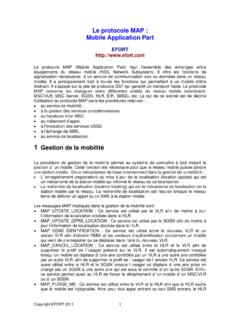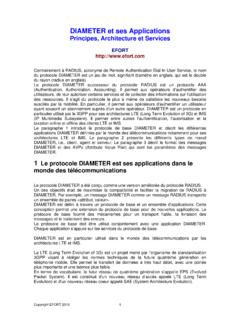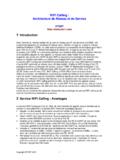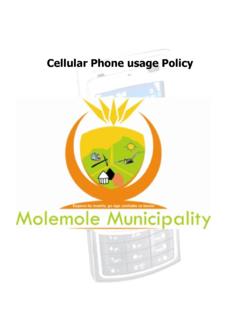Transcription of DIAMETER Signaling Network in EPS : Principles …
1 Copyright EFORT 20121 DIAMETER Signaling Network in EPS : Principles and Introduction2G/3G Mobile Networks consist of a circuit switched core Network on one side and a packetswitched core Network on the other side. The circuit switched domain is called R4 and ismade of MSC Servers and MGWs; it provides telephony services including supplementaryservices, value added telephony services, SMS, USSD-based services, packet switched domain is called GPRS and consists of SGSNs and GGSNs andprovides access to IP-based networks such as Internet and Signaling protocols used in the circuit switched domain are : MAP (Mobile Application Part) for GSM mobility management, SMS transfer, USSD-based services, location-based services, etc. INAP (Intelligent Network Application Part) and CAP (CAMEL Application Part) for theinvocation of Intelligent Network services such as prepaid, VPN, short number services ISUP for the establishment and release of voice calls with external TDM-based networks BICC/SIP-I for the establishment and release of calls with other MSC Signaling protocols used in the packet switched domain are : MAP (Mobile Application Part) for GPRS mobility management and SMS transfer GTPv1-C (GPRS Tunnel Protocol - Control Plane) for the establishment and release ofbearers (called PDP contexts) used for the transport with mobility of IP packetssent/received by the UE.
2 DIAMETER for policy and charging the evolution of mobile networks towards a 4G Network called EPS (Evolved PacketSystem) which is a all-IP mobile Network , Signaling protocols should be designed directlyover IP. The new core Network consists of a packet switched domain named ePC (EvolvedPacket Core). The associated Signaling protocols are : DIAMETER which remains the protocol for policy and charging control DIAMETER for EPS mobility management; it replaces MAP used for mobilitymanagement in GPRS GTPv2-C (GPRS Tunnel Protocol - Control Plane) for the establishment and release ofbearersThe new circuit switched domain is IMS (IP Multimedia Subsystem) which Signaling protocolsare : DIAMETER for IMS mobility management (registration, re-registration, de-registration) SIP for the establishment/release of multimedia sessions including telephony sessions aswell as for SMS delivery SIP for the invocation of IMS-based service platforms DIAMETER for policy and charging (online and offline) EFORT 20122 When considering a roaming scenario, the main Signaling protocol use between the 2G/3 Gvisited Network and the home Network is MAP.
3 DIAMETER replaces it for EPS evolution of some SS7 protocols particularly MAP towards DIAMETER requires anassociated Signaling Network . In SS7, the preferred mode of operation is quasi-associatedmode with STPs ( Signaling Transfer Point) present in the operators networks as well as atthe international level. This enables the routing of Signaling between operators (especially incase of roaming). DIAMETER requires the same mode of operation with the introduction ofDIAMETER agent. The DIAMETER agent is the DIAMETER Signaling goal of this tutorial is to show the usage of DIAMETER in mobile networks. The secondsection shows the EPS architecture highlighting the importance of DIAMETER for EPSinterfaces. The third section presents the role of the Agent and its advantages compared to aDIAMETER Signaling Network operating in associated mode. The fourth section describesEPS roaming and the need of Agents particularly at the international EPS Architecture and DIAMETER presenceThe EPS Network consists of an access Network called LTE (Long Term Evolution) and anew packet switched core Network called ePC (Evolved Packet Core).
4 The entities involvedin EPS are (Figure 1): eNodeB : The eNB is the entity responsible for radio interface transmission andreception. Unlike 2G and 3G Network , no radio Network controller is present. S1 is theinterface between eNodeB and the core Network . MME (Mobility Management Entity) handles the control plane Signaling , and especially formobility and idle-mode handling. The SGW (Serving GW) routes the UE originated IP packets to the PDN GW andtransfers the incoming packets to UE via the access Network ( , eNodeB). It performslawful interception and charging per user for the inter-operator billing. The PGW (Packet Data Network Gateway) is the edge router between the EPS andexternal packet data networks. It is the highest level mobility anchor in the system, andusually it acts as the IP point of attachment for the UE. It performs flow-based policy andcharging.
5 The HSS (Home Subscriber Server) is the database handling the subscription data of theEPS user. The PCRF (Policy and Charging Rules Function) provides PCC (policy and Charging)rules to the PCEF to enable the PCEF authorizing/blocking/restricting and charging the IPflows originated and received by the UE. The PCEF (Policy and Charging Enforcement Function) executes the PCC rules obtainedfrom the PCRF. It applies shallow or deep packet inspection on any IP packet for policycontrol and invokes the OCS or OFCS for charging. The OCS (Online Charging Subsystem) provides online (or real-time) credit control andquota management for subscriber data sessions. The OFCS (Offline Charging Subsystem) receives charging data in the form of ChargingData Records (CDRs) and DIAMETER accounting messages from Network elements afterthe subscriber incurs Network resource large number of EPS interfaces is based on DIAMETER .
6 The following list is notexhaustive : S6 (EPS) : S6 interface enables transfer of subscription and authentication data forauthenticating/authorizing user access to the EPS. This interface is between MME(Mobility Management Entity) and HSS (Home Subscriber Server).Copyright EFORT 20123 S13 (EPS) : S13 interface is used for IMEI check. This interface is between MMEand EIR (Equipment Identity Register). Gx (EPS) : Gx interface allows the PCEF ( , PDN GW) obtaining policy andcharging rules from the PCRF. With those rules, PCEF knows how toauthorize/block/restrict IP flows and charge those flows. Gy (EPS) : Gy is the online charging interface between the PCEF ( , PDN GW)and the OCS (Online Charging System) Gz (EPS) : Gz is the offline charging interface between the PCEF ( , PDN-GW)and the OFCS (Offline Charging System). S9 (EPS) : S9 is the interface between the PCRF in a visited Network and thePCRF in the home Network .
7 This interface is used when the PDN GW whoterminates the bearers of the visiting user, belongs to the visited Network (notpresented on figure 1). Rx (EPS) : Rx is the interface enabling IMS to request access Network resources( , dedicated bearer) to guarantee the quality of service of the IMS sessions. Rxis between IMS and the PCRF. Cx (IMS) : Cx is the interface between the IMS call servers and the IMS databasecalled HSS to authenticate, authorize and locate the user. Sh (IMS) : Sh is the interface between IMS Application Servers (ASs) and the HSSto obtain service data required for service execution. Rf (IMS) : Rf is the offline charging interface between IMS entities and the OFCSfor offline charging of IMS sessions and services. Ro (IMS) : Ro is the online charging interface between IMS entities and the 1: EPS Architecture and DIAMETER InterfacesServing GWIP NetworkUEeNode BIP NetworkPDN GWMMELTEePCIMSHSSS6 GxRxCx, ShS11S5 OCSOFCSGyGzRoRfDIAMETER InterfacePCEFLTE : Long Term EvolutionePC : Evolved Packet CoreMME : Mobility Management EntityPCRF : Policy and Charging Rules Function PCEF : Policy and Charging Enforcement FunctionHSS : Home Subscriber ServerIMS : IP Multimedia SubsystemOCS : Online Charging SystemOFCS : Offline Charging SystemEIR : Equipment Identity RegisterPCRFC ontrol planeUser planeIP NetworkS1-CS1-US13 EIRC opyright EFORT 201243 DIAMETER Agent for EPSFor scalability and configuration simplicity, the quasi-association mode should be chosen byservice providers for DIAMETER Signaling transport.
8 An agent (similar to STP inSS7/SIGTRAN networks) links all the DIAMETER nodes (MME, HSS, PCEF, PCRF, OCS,OFCS, all IMS entities, etc.) and routes the DIAMETER requests/answers between them. AllDIAMETER nodes have one entry in their routing table to deliver any DIAMETER messageto the Agent. The DIAMETER agent is able to route between nodes of the same Network orbetween nodes of different networks. To ensure 100% availability, agents are deployed bymatted pair. Every DIAMETER client or server is connected to the two Agents of that 2 : DIAMETER Agent in EPSA gents bring a number of advantages to the EPS architecture : Scalability : Considering N entities which need to interact with M entities, the number ofTCP or SCTP connections between them is NxM if no DIAMETER agent is number is N+M if an agent is present. There is a need of quasi-associated modewith agents to guarantee scalability of the DIAMETER Signaling architecture.
9 Simplification of the Network extension : The introduction of a new DIAMETER client orserver in the EPS leads to the update of the routing tables of all the entities which need tocommunicate with the new entity, if no agent is involved. With the presence of an agent,only the routing tables of the agent and the new entity are impacted. Network interconnection with topology hiding : The agent enables simplifying theinterconnection with other networks for the support of roaming agreements. The agentalso hides the topology of the internal Network . Application layer routing : The agent enables performing application-based routing suchas load balancing in the context of PCC (Policy and Charging Control), HSS identificationin the case of interaction between MME and HSS, Interface PCEFOFCSOCSPCRFMMEA gentMMEHSSPCRFPDN GWOCSOFCSS4-SGSNIMS I-CSCF S-CSCF P-CSCF AS MRF MGCF BGCFS6aPCEFA gentS6a, S6d, SWx,Cx, ShGz, RfGy, Ro,Rc, ReGx, S9, RxGx, Gy, GzS6dCx, Sh,Rx, Ro, RfCopyright EFORT 20125 AAA protocol conversion : Translation agents are important when migration toDIAMETER occurs.
10 They support interconnection with other domains applying other AAAprotocols. As examples the DIAMETER agent may translate MAP into DIAMETER , CAPinto DIAMETER , DIAMETER into RADIUS, EPS Roaming and DIAMETERA ssume a roaming scenario where an Orange France user is served by a visited networkcalled Mobistar in visited MME from Mobistar derives the home domain name of the LTE mobile user withhis IMSI. If IMSI is 208019999999999, then home domain name (This equals to Orange France)1. MME looks up its routing table and identifies that for any destination, the next hope is theMobistar relay agent. An SCTP association exists between the MME and the relay it sends the DIAMETER S6 Authentication Information Request (AIR) over that SCTP association. The DIAMETER request provides the following AVPs : Origin host, origin realm,destination realm.














